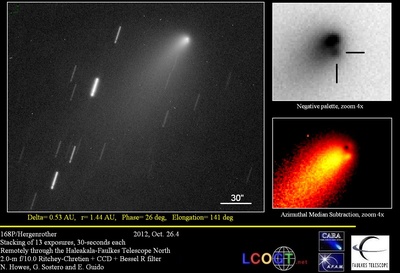Splitting event in comet 168P/Hergenrother
This has triggered the attention of amateur and professional astronomers alike. Most of the time these brightening events (comets are among the most unpredictable astronomical objects from themselves) originate from some activity within, or associated with, the nucleus of the comet. There were strong assumptions in the astronomical community on the possible emergence of some visible fragments in the coma, the potential consequences of a break-up of in the comet's nucleus.
There have even been a few claims relating to a sighting within the comet hunting community, however these turned out to be most likely false alarms, due to the unfavourable combination of seeing/instrumental resolution within the amateur community. Our team have been monitoring the evolution of this comet with a variety of instruments including the research grade Faulkes Telescopes, with sub arcsecond imaging capability.
Today...we found the fragment...
Our team performed follow-up observations of comet 168P/Hergenrother on 2012, Oct. 26.4, remotely through the Faulkes Telescope North (Haleakala) under good seeing conditions, and a scale of 0.3"/px.
Stacking of 13 R-filtered exposures, 30-sec each, obtained remotely, from the Haleakala-Faulkes Telescope North on 2012, Oct. 26.4, through a 2.0-m f/10.0 Ritchey-Chretien + CCD, under good seeing conditions, shows the presence of a secondary nucleus, or fragment, placed about 2" in PA 188 with respect to the main central condensation of comet 168P.
The magnitude of this fragment was measured to be R about 17, and it shows a diffuse coma nearly 2" in diameter.
Below you can see an animation obtained by means of the same frames (here East is to the left, North is to the bottom). Click here for a bigger version.
Below you can find the astrometry lines (0168P: main nucleus of comet Hergenrother, 168Pb the new fragment we discovered today):
0168P KC2012 10 26.42126 23 41 31.60 +34 07 36.5 15.6 N F65
0168P KC2012 10 26.42747 23 41 31.37 +34 07 44.6 14.3 N F65
0168P KC2012 10 26.42901 23 41 31.31 +34 07 46.6 15.7 N F65
168Pb KC2012 10 26.42126 23 41 31.57 +34 07 34.5 17.2 R F65
168Pb KC2012 10 26.42747 23 41 31.32 +34 07 42.3 16.9 R F65
168Pb KC2012 10 26.42901 23 41 31.28 +34 07 44.3 17.4 R F65
There was no evidence of this fragment in our previus follow-up images, obtained through the Faulkes Telescopes 2.0-m f/10.0 Ritchey-Chretien + CCD on 2012, Oct. 22.4 and Oct. 3.6, to limiting magnitude about 19.. See our previous post about comet 168P here and here.
by Giovanni Sostero, Nick Howes & Ernesto Guido

